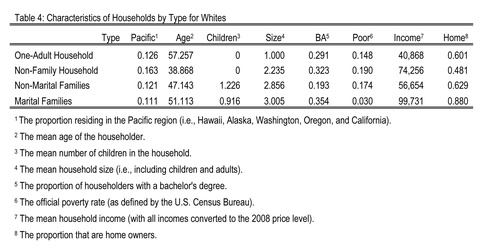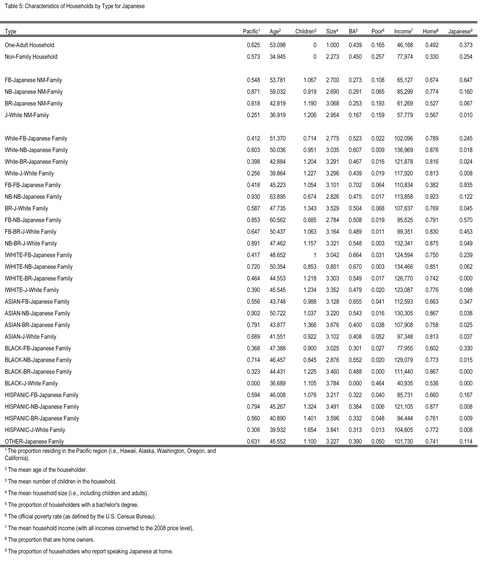>> Part 6
CHARACTERISTICS OF CONTEMPORARY WHITE AND JAPANESE AMERICAN HOUSEHOLDS
Table 4 displays some descriptive characteristics for White households in terms of basic demographic indicators, while Table 5 shows these characteristics for JA households. The indicators include the proportion residing in the Pacific region (i.e., Hawaii, Alaska, Washington, Oregon, and California), the mean age of the householder, the mean number of children in the household, the mean household size (i.e., including children and adults), the proportion of householders with a bachelor’s degree, the official poverty rate (as defined by the U.S. Census Bureau), the mean household income (with all incomes converted to the 2008 price level), and the proportion that are home owners. Table 4 shows that only about one in eight White households resides in the Pacific region although the proportion is slightly higher among non-family households. By definition, one-adult households and non-family households do not include any children (i.e., the mean number of children for these two types of households is 0). One-adult households tend to be older and they tend to have lower household incomes in part due to the fact they have (at most) only one earner in the household. Nonetheless, 60.12% of one-adult households own their own homes and their poverty rate is lower than that of non-family households and non-marital families. By contrast, non-family households tend to be younger and are less likely to own their own homes.
Non-marital families have the highest mean number of children (1.23) and the lowest proportion with a bachelor’s degree (19.3%). They also have a fairly high poverty rate (17.4%). On average, marital families have slightly less than one child, the highest proportion of bachelor’s degrees, the highest household income, the lowest poverty rate, the largest household size, and the highest proportion of home ownership.
Table 5 shows these statistics for JA households. As was described earlier, the classification of JA families is broken down in a more detailed manner. Readers should be aware, however, that the descriptive statistics in Table 5 for Asian-J-White families and Black-J-White families are unreliable due to the small sample sizes for these two relatively uncommon household categories.
The results shown in Table 5 indicate that most types of JA households are much more likely than Whites to reside in the Pacific region. This location is especially prevalent for households with an NB-Japanese householder or spouse. Japanese language usage at home is relatively uncommon except for those households that have an FB-Japanese householder or spouse (Kim and Min 2010). At one extreme, 93.5% of FB-FB Japanese families speak Japanese at home, but the much smaller 1.8% figure for White-NB-Japanese families is more typical of households that do not include an FB-Japanese.
In terms of the mean age of the householders, White-NB Japanese families are substantially older than White-BR-Japanese families who are in turn older than White-J-White families. The same general pattern is even more evident among non-marital families. Although only suggestive, these results are consistent with the assumption that J-White householders may tend to have a higher generational status than BR-Japanese householders who in turn may tend to have a higher generational status than NB-Japanese householders. The mean age of householders among NB-NB Japanese families is notably older (i.e., about 64 years) suggesting that many of these marriages may have occurred in earlier decades when racial intermarriage among the Nisei was lower.
In general, JA families tend to have above average educational attainment. In regard to the most common marital family categories, the proportion with a bachelor’s degree is 52.3% among White-FB-Japanese families, 47.5% among NB-NB Japanese families, 60.7% among White-NB-Japanese families, 70.2% among FB-FB Japanese families, 46.7% among White-BR-Japanese families, and 54.3% among Asian-NB-Japanese families (as shown in Table 5) in comparison to the substantially lower proportion of 35.4% among White marital families (as shown in Table 4). Our results seem largely consistent with the broad conclusion reached by Takei, Sakamoto, and Woo (2006) that Japanese Americans most closely associated with FB-Japanese tend to have higher levels of educational attainment. Takei, Sakamoto, and Woo (2006) further find high levels of educational attainment among persons who identify as Chinese-Japanese which seems consistent with the above mentioned result for Asian-NB-Japanese families because intermarriage with Chinese is likely to be the most common type of Asian intermarriage for Japanese Americans (Takei, Sakamoto, and Woo 2006).
Not surprisingly, other results in Table 5 indicate that JA household types with high proportions of bachelor’s degrees tend to have high household incomes and low poverty rates. For example, among NB-NB Japanese families, mean household income is $113,858 and the poverty rate is 1.7%. These results indicate a higher level of socioeconomic status than for White marital families whose mean household income is $99,731 and whose poverty rate is 3.0% as shown in Table 4. In general, most types of JA households have higher levels of socioeconomic attainments than Whites.
Next - Part 8: Summary and Conclusion
* The following article is a shortened version of a chapter to appear in Ethnic Families in America: Patterns and Variations, 5th Edition, edited by Roosevelt Wright, Charles H. Mindel, Robert W. Habenstin, and Than Van Tran.
© 2010 Arthur Sakamoto, ChangHwan Kim, and Isao Takei







